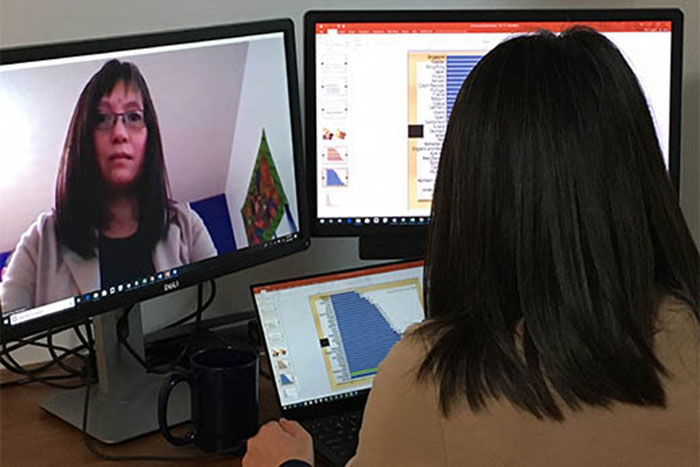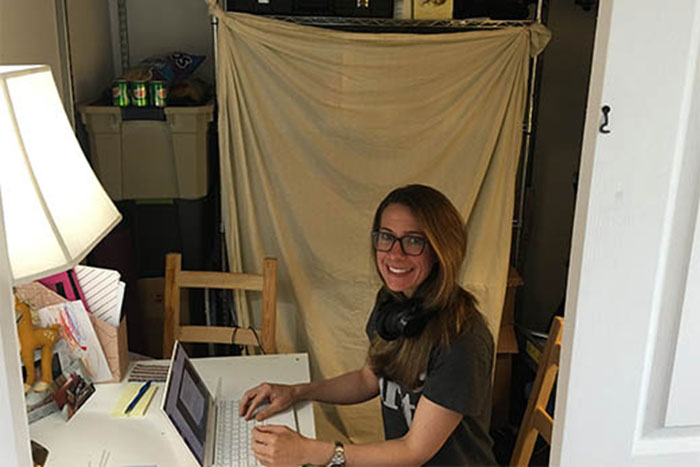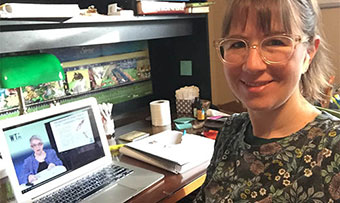For nursing student Jessie Bracewell, transitioning to remote learning meant finding new ways to balance classwork while caring for her family. For professor Quyen Phan, it meant supplementing hands-on clinical training with comparable virtual activities.
“Classes that Click” is a series showcasing how Emory’s commitment to stellar education continues during the COVID-19 pandemic and how many lessons learned will further enhance life at the university when everyone returns to classrooms together.
In this edition, Phan, assistant clinical professor in the Nell Woodruff Hodgson School of Nursing, shares how she and other faculty have adapted classes for remote environments, even those that include clinical components. Phan is joined by Bracewell and Dara Suschke, two students in the School of Nursing’s Accelerated BSN program, which allows those with bachelor’s degrees in other disciplines to earn a BSN in 15 months.
The course: “Population Health” (Nursing 315)
“Population Health: Community and Public Health Nursing” (Nursing 315) prepares students to provide clinical prevention and population-based health care across the lifespan. Emphasis is on population-focused health promotion, disease and injury prevention care, and social determinants of health to improve the nation's health.
Moving toward remote learning
How did you prepare for this phase of remote learning?
Phan: Thanks to the training I received from Emory’s Center for Faculty Development and Education, I was open to trying different ways to incorporate technology. I had adopted a hybrid teaching format for this class just a couple of months before everything moved online. I want to make my class more engaging to the diverse student body with so many different backgrounds and learning styles, so I used Zoom to put together a panel discussion with speakers from rural Georgia in a recent semester.
Bracewell: Prior to the current shift to remote learning, we outfitted a spare closet to function as an office; my daughter has dubbed this space “the work hole.”
What was one of your primary challenges in shifting to a remote format and how did you meet it?
Phan: With a class of 180 students in two sections, it would be nearly impossible to set up faculty-moderator class discussion. Thanks to support through the CFDE teaching fellowship program, we were able to create online peer-moderator small groups for discussion on Canvas. This allows us to deep dive into some content areas that we would not be able to explore in class otherwise.
We found several ways to supplement our students’ clinical activities prior to moving our classes online. The School of Nursing purchased access to a simulation product that allows students to do virtual activities and our team of clinical faculty trained on the product prior to rolling it out to students on the first day of remote learning.
Our students are on standby to help virtually staff the Georgia Department of Public Health's triage phone line if they move triage to a remote service (currently, the triage line still requires volunteers to be at the GDPH headquarters). We’re also supplementing their clinical hours by getting students trained on Disaster Health Response by the American Red Cross. The Red Cross provides training to health professional students online, which is particularly applicable in light of the pandemic.
Bracewell: My primary challenge during this transition has been juggling the responsibilities of home life while wrapping up a hectic semester. My husband works full-time from our home and our two children (ages 2 and 7) have had their learning shifted to online platforms as well. Balancing all of this means that my studying happens early in the morning or late at night when everyone else sleeps.
Suschke: I tend to structure my to-do list around places I have to go that day (whether it’s class or clinical). Now that everything is virtual and I’m at home all day, I have to be more disciplined about how I structure my day.
Putting remote learning into practice
What has been a pleasant surprise about remote learning?
Phan: One of the biggest surprises is how smooth the transition to remote teaching has been for me thanks to the hybrid format that was already in place. I’ve received some positive feedback regarding the hybrid teaching format; I have also received some great constructive feedback on making the activities more useful.
The instructional design and technology support teams have been amazingly supportive of the faculty’s transition to remote teaching. The other surprising thing about this whole process is how wonderfully supportive our own faculty members are to each other, serving as a back-up person during our live Zoom lectures and trouble-shooting glitches.
Suschke: Because I tend to be more of an introvert, this allows me to be in my comfort zone at home while I learn. Also, because I don’t have to commute anywhere, I feel like I have extra time in the day to exercise and prepare food. I enjoy moving through the day at my own pace.
Bracewell: I’ve been pleasantly surprised by how my cohort has been able to sustain a sense of community by connecting online.
How are you staying engaged with your students or classmates and professors?
Phan: As a coordinator of my course, which has both didactic and clinical components, I work closely with the clinical instructors to ensure at least a weekly synchronous meeting. I have synchronous activities during the scheduled class time and record the lecture for asynchronous student access. I’m also keeping my regular office hours via Zoom.
Suschke: I enjoy seeing all my classmates and professors on classes through Zoom. The professors have been great about being accessible and flexible. Our cohort uses GroupMe to share information, check in with each other, collaborate on projects and share funny pictures and memes. It was fun one day when everyone shared photos of their at-home study buddies, which included lots of cute pets and children.
Lessons to be carried forward
What’s one lesson you’ve learned during this transition, and how will you use it later?
Bracewell: I’ve learned to smile, take a deep breath and trust that everything will work out. Everyone is working hard to make this transition successful. I’ve also realized that the extra time with my family is a gift. I’m tired, but the extra work will be worth it in the end. I will carry this resilience forward.
Suschke: I’m sure there will be more lessons down the road, but one so far is to be flexible and to get comfortable with ambiguity. This will stay with me as other unexpected circumstances emerge moving forward both in the “normal” classroom setting and in my future career as a nurse.
In addition to focusing on the university’s educational mission, Emory experts are on the front lines of the pandemic – caring for patients, researching possible treatments and vaccines and sharing knowledge to help inform and prepare the public. Visit Emory’s COVID-19 page for the latest updates.



